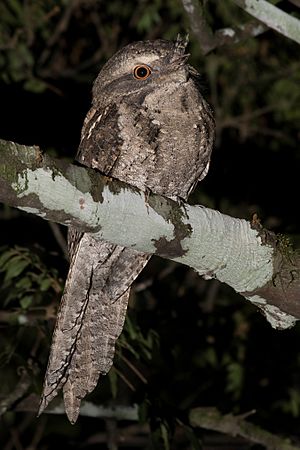Marbled frogmouth facts for kids
Quick facts for kids Marbled frogmouth |
|
|---|---|
 |
|
| In Mount Glorious, Queensland, Australia | |
| Conservation status | |
| Scientific classification | |
| Genus: |
Podargus
|
| Species: |
ocellatus
|
The marbled frogmouth (Podargus ocellatus) is a special type of bird that belongs to the Podargidae family. It was first described by scientists Jean René Constant Quoy and Joseph Paul Gaimard in 1830. You can find this bird in places like the Aru Islands, New Guinea, and Queensland, Australia.
These birds love to live in certain kinds of forests. Their natural habitats are warm, wet forests in low areas or in mountains. They prefer places where the trees are tall and the air is humid.
Contents
Types of Marbled Frogmouths
There are five different types, or subspecies, of the marbled frogmouth. Each one lives in a specific area.
Where They Live
- The main type, called ocellatus, lives in New Guinea and the islands around it.
- Two types live on islands that are part of Papua New Guinea.
- intermedius is found on the Trobriand Islands and D'Entrecasteaux Islands.
- meeki lives only on Tagula Island.
- Australia has two types.
- marmoratus lives on the Cape York Peninsula.
- plumiferus is found in southeast Queensland. People sometimes call this one the plumed frogmouth.
Home of the Plumed Frogmouth
The Conondale ranges in Queensland's Sunshine Coast are a very important home for the plumed frogmouth. Many of these birds live inside the Conondale National Park.
Why They Are Special
This bird is quite rare. In Queensland, it is listed as a vulnerable species. This means its population is not very big, and it needs protection. It lives in subtropical rainforests and vineforests. These forests are usually found at heights between 50 and 800 meters above sea level.
The marbled frogmouth is very good at hiding. It usually rests high up in the trees. Because it blends in so well, it is very hard for people to find or study them.
Threats to Their Habitat
The plumed frogmouths are facing some challenges. Their homes are at risk from things like:
- Land clearing: When forests are cut down for other uses.
- Fire: Fires that are not natural or controlled properly.
- Timber harvesting: When trees are cut down for wood.
Scientists also worry about how climate change might affect their homes in the future.
Current Population
Experts believe there are about 800 pairs of plumed frogmouths in the Conondale ranges. Their current living area is just under 2,000 hectares. There's hope that some areas where rainforests are growing back might become new homes for them. However, these birds need very specific, untouched forests to live in. This makes them very vulnerable when their habitat shrinks. Cutting down more trees in the Conondale region could also harm them.
Related Birds
Another bird, Rigidipenna inexpectatus, used to be thought of as a type of marbled frogmouth. This bird lives only on four islands in the Solomon Islands. In 2007, scientists decided it was different enough to be put into its own group, called Rigidipenna.
Images for kids
-
Subspecies plumiferus in Mount Glorious, Queensland, Australia
See also
 In Spanish: Podargo ocelado para niños
In Spanish: Podargo ocelado para niños



